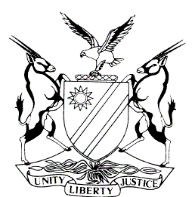REPUBLIC OF NAMIBIA

IN THE HIGH COURT OF NAMIBIA, MAIN DIVISION, WINDHOEK
REVIEW JUDGMENT
Case Title: The State v Andreas Namwere Sipahu
| Case No: CR 26/2021 |
High Court MD Review No: 1403/2020
| Division of Court: Main Division |
Heard before: Judge Claasen et Judge Usiku
| Delivered on: 16 April 2021 |
Neutral citation: S v Sipahu (CR 26 /2021) [2021] NAHCMD 163 (16 April 2021) |
The order: The conviction and sentence are set aside. The case is remitted to the trial court in terms of s 312 of Act 51 of 1977 with the direction to act in terms of s 113(1) and to bring proceedings to its natural conclusion. In the event of a conviction the sentence already served by the accused must be taken into account.
|
Reasons for order: |
Claasen J (concurring Usiku J)
This is a review in terms of section 302(1) of the Criminal Procedure Act 51 of 1977 as amended, (hereinafter referred to as the CPA).
The accused was charged and convicted of the offence of: Assault with intent to do grievous bodily harm and was fined N$ 4 000-00 (Four Thousand Dollars) or Thirty six (36) months imprisonment. The review cover indicates that the court fine was not paid.
When the case came on automatic review a query was raised. The main points therein were whether the conviction is valid in view of the accused’s ‘staggering drunk’ condition at the time and whether the term of imprisonment was proportional to the fine.
Reverting to the questioning in terms of s 112(1)(b) of the CPA, there could have been no doubt as to the state of the accused when he committed the offence in question. The relevant part is reproduced below: ‘Q: Why did you take the law in your hands? A: I was drunk Q: How many people were present? A: There were only the two of us at the scene Q: Where did you intoxicate yourself from? A: We first consumed liquor at one place then at the place where I assaulted him. Q: At which place did you realize that you were intoxicated from? A: At the place where the incident took place Q: How intoxicated were you? A: I was staggering’ (sic) ( My emphasis)
The record also shows that the magistrate registered that the accused was raising a defence as she recorded that: ‘He has admitted the elements of the offence. He raised drunkenness as a defence. But his conduct during the commission of this offense is not compatible to that of a drunkard person. He pulled the stick out of the fence and he could aim at the complainant and to any other person or object.’ On that basis the accused was convicted as charged.
The purpose of s 112(1)(b) questioning is twofold, namely to establish the factual basis for the plea of guilty and to establish the legal basis for such a plea. Embedded in that process is certain protocols. The headnote in S v Combo and Another put it in plain words: ‘When questioning an accused in terms of s 112(1)(b) of the Criminal Procedure Act on the accused’s plea of guilty, a magistrate must make sure that the accused admits all the elements of the offence. If there is any doubt as to the guilt of the accused, a plea of not guilty should be entered and the necessary evidence should be lead to establish his guilt.’ In returning to the answers by the accused in this case, he was ‘staggering’ which verb is defined in the Merriam-Webster’s Dictionary and Thesaurus as ‘to reel from side to side.’ This is anything but a convincing picture that the accused, being is such condition at the time, was in possession of the capacity to know and appreciate the wrongfulness of his actions.
A question related to the above is whether it was appropriate for the Magistrate to reason that, although the accused told her he was intoxicated, his actions were not in accordance with a drunkard? It is also an established principle that the procedure embarked upon by the Magistrate to make certain inferences during the process of s 112(1)(b) of the CPA was not correct. It was held in S v Kaeverua that the function of the court is not to evaluate the answers as if it were weighing evidence, neither does it have to decide the truthfulness of the answers or draw inferences from there.
In her reply, as far as the first point is concerned the Magistrate concedes that a different path should have been followed, that of entering a plea of not guilty in terms of s 113 of the CPA. As for sentencing, the Magistrate also accepts that the ratio between the fine and imprisonment was disproportionate.
For these reasons, the conviction and sentence are not in accordance with justice and are set aside.
In the result the following order is made: The conviction and sentence are set aside. The case is remitted to the trial court in terms of s 312 of Act 51 of 1977 with the direction to act in terms of s 113(1) and to bring proceedings to its natural conclusion. In the event of a conviction the sentence already served by the accused must be taken into account.
|
|
|
C M CLAASEN JUDGE | D N USIKU JUDGE |
